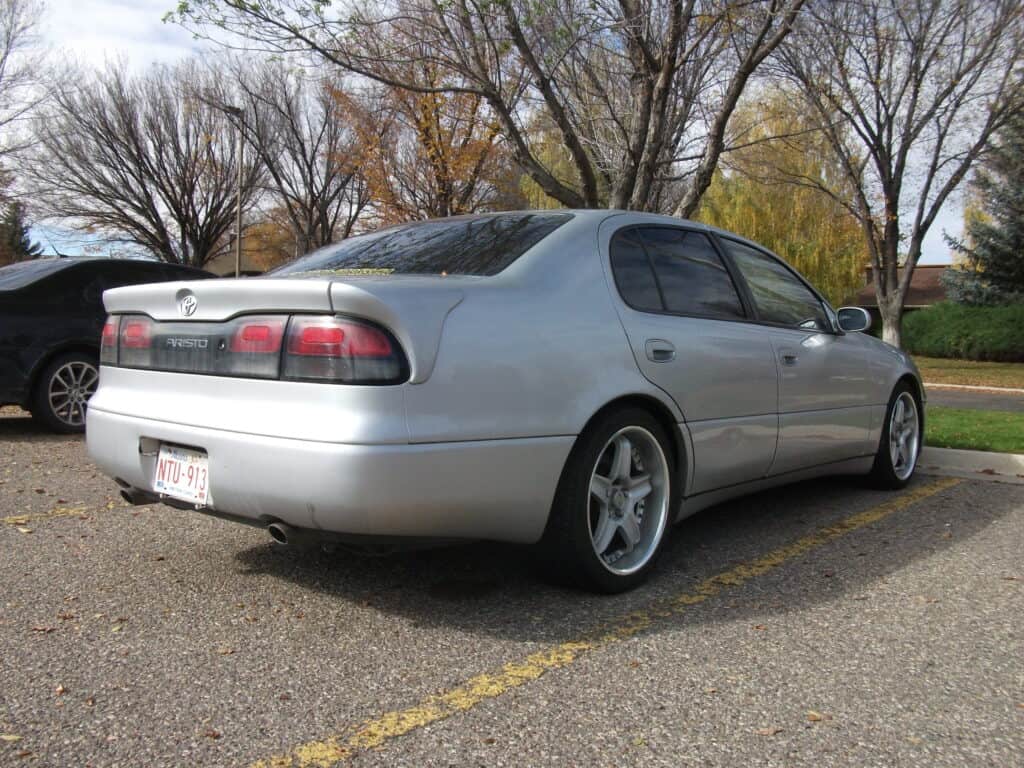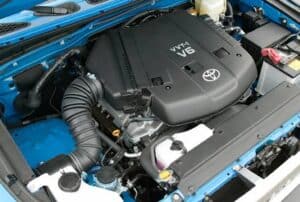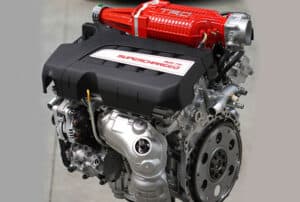Toyota Aristo – Everything You Need To Know
Table of Contents
Have you ever wondered why the Aristo gets so much hype? If so, there’s likely more to the Toyota luxobarge than you realize. Here’s what you need to know.

Image credit: Flickr
Toyota’s Aristo is Japan’s ultimate executive sedan, which also doubles as (arguably) the world’s greatest stock sleeper car. For those unfamiliar with the name, the Aristo hides something very special under the hood.
Toyota derived the Aristo’s name from Aristotle, which translates to “highest purpose,” combined with “Aristos,” which is the ancient Greek word for “best.”

Image credit: Fitment Industries
Designed as a comfort cruiser, it provides plush leather, walnut trim, and all the luxury touches you’d expect from an executive sedan. It serves as both a luxury sedan and a true family hauler, making it perfect for daily driving while also being more than capable of shredding tires when required!
While Toyota never brought the Aristo to North America, they did introduce the Lexus GS300, which is essentially the same car with one crucial difference. The Japanese Domestic Market (JDM) Aristo came with engine options that weren’t available in the US, most impressive of all being the holy grail 2JZ-GTE under the hood.

Image credit: Wikimedia Commons
Of course, this is the same powerplant that made the MK4 Supra one of the most sought-after JDM cars, and the Aristo was the only other vehicle to ever receive the same twin-turbo GTE variant, in a “sensible” four-door sedan package, no less!
The combination of luxury and performance was so effective that the Aristo eventually earned the distinction of being Japan’s most stolen car, typically stripped of its engine and often found in abundance in other Asian countries. (If you know, you know!)
In addition to being a perfect daily and a potentially ideal drifter, the Aristo is also incredibly popular with the JDM VIP tuning community (for obvious reasons!)
Now that they’re finally old enough to bypass America’s 25-year import rule, these JDM models are finally making their way stateside, and they’re cheaper than you might think! (More on that later.)
The Aristo represents everything awesome about 90s JDM engineering – reliable Toyota build quality, Lexus-level luxury, and Supra-grade performance wrapped in a package that won’t raise eyebrows (with anyone other than enthusiasts, of course!)
For us, the Aristo is the perfect sleeper. It’s understated enough that most people won’t look twice, yet capable of embarrassing most modern-day sports cars at the lights.
At the same time, it’s a practical, exceptionally well-built four-door sedan. What more could you ask for?!
Not sold yet? Well, you know what they say – more doors, more whor… *ahem*
Let’s dive into everything you could ever need to know about the epic Toyota Aristo!
Aristo Origins
The Aristo emerged in October 1991 as Toyota’s solution to a dealer network problem during Japan’s bubble economy. Toyota needed a luxury sedan to fill gaps where certain dealer chains couldn’t get the Crown Majesta, so they created the Aristo to ensure every Toyota dealer had a premium offering.
The initial styling on the MK1 was from Italdesign, the Italian firm behind icons like the Maserati Ghibli, Lotus Esprit, and the BMW M1 (plus everyday heroes like the Volkswagen Golf). The design brought European vibes that stood apart from other Japanese luxury cars of the era.
Toyota built every Aristo at its Tahara assembly plant in Japan, where robots handled 4,200 welds per body while humans did just eight spot welds by hand. This manufacturing was cutting-edge stuff back in 1991.
The Aristo sat at the top of Toyota’s dealer hierarchy, positioned above the Chaser at Toyota Auto Store and above the Cresta at Toyota Vista Store.
Aristos are right-hand drive only, made exclusively for the Japanese market, while the left-hand drive Lexus GS handled export duties. More on how they stack up against one another later!
First Generation Aristo (MK1) – 1991-1997

Image credit: Wikimedia Commons
The first-generation Aristo was launched with three engine options, and all Aristos throughout its 14-year lifespan came with automatic transmission only (unfortunately!)

Image credit: Wikimedia Commons
Engine Lineup
3.0Q (JZS147) – The base 3.0Q came with the naturally aspirated 2JZ-GE producing 227 hp.
3.0V (JZS147) – This stepped things up with the legendary twin-turbo 2JZ-GTE making 276 hp (albeit under Japan’s “Gentleman’s agreement”). This made the Aristo a family-friendly four-door Supra.
4.0Zi-Four (UZS143) – In October 1992, Toyota added the 1UZ-FE V8, producing 249 hp. This came standard with Toyota’s iFour all-wheel drive system, making it one of the first luxury sedans to combine a V8 with AWD technology. Previously, the 1UZ-FE had already proven itself in the first-generation Lexus LS and Crown Majesta.
Interior and Features
Its standard equipment was genuinely impressive for the early 90s, featuring leather everything, alongside features such as an electronically adjustable steering wheel, a moonroof, and a 12-CD changer.
Toyota also demonstrated its long-distance touring capabilities (or, in our case, its drift day needs!) with a massive 19.8-gallon fuel tank. Even with the thirsty twin-turbo, you’re able to cover plenty of ground between fill-ups.
Safety wasn’t overlooked either – dual airbags came standard across all trim levels, too, which was surprisingly rare for its era.
Second Generation Aristo (MK2) – 1997-2005

Image credit: Flickr
The second-generation launched in August 1997 with a complete redesign that Toyota claims made it the fastest production sedan in the world, even quicker than the BMW M5 of the time, which was a clear rival.

Image credit: Wikimedia Commons
Platform & Design Changes
Toyota developed an entirely new front-engine, rear-wheel drive platform for the MK2, which became the foundation for its future RWD sedans, including the Japanese-market Crown.
The styling moved in-house at Toyota, featuring distinctive quadruple headlights with elliptical inner lenses that echoed the Lexus SC coupe design. Its modern styling typically makes it the more sought-after of the two Aristo generations.
Engine Lineup
The second generation simplified things by dropping the V8 option, focusing exclusively on the 2JZ inline-six engines. Both variants now featured VVT-i variable valve timing as standard, which boosted torque across the entire rev range.
S300 (JZS160) – The naturally aspirated 2JZ-GE produces 230 hp.
V300 (JZS161) – Again featuring the highly sought-after twin-turbo 2JZ-GTE, this time making 276 hp. The V300 also came loaded with advanced tech, including optional electronic four-wheel steering, VSC stability control, and a tiptronic-style automatic transmission with steering wheel-mounted shift buttons.
The V300’s 2JZ-GTE holds special significance as the Aristo became the last production car to feature the legendary engine, continuing three years after the Supra was discontinued in 2002.
Unfortunately, the automatic gearbox remained the only option, with no manual Aristos ever rolling out of Toyota’s factories (not that it can’t be done!)
Special Editions
Both S300 and V300 models offered Vertex Edition packages as premium trim levels.
S300 Vertex Edition – The S300 Vertex came standard with 16-inch alloy wheels fitted with 225/55R16 tires (stock are 215/60R16). Inside, there are heated leather seats and dark ash wood trim, creating a two-tone cabin appearance. The package also included a rear spoiler and Vertex badging.
V300 Vertex Edition – The V300 Vertex features upgraded 17-inch alloy wheels with wider 235/45ZR17 tires (stock are 215/60R16.) Inside, you get heated leather seats and dark wood trim from the S300, plus the rear spoiler and Vertex badges.
Some V300 Vertex models came equipped with Active Rear Steering (ARS) and optional uprated Bilstein suspension components.
TOM’S Editions – For those seeking ultimate exclusivity, TOM’S created rare, limited-edition variants – the V300, VA300, and VA300 G.
Under the hood, the TOM’S Aristos improve upon the Vertex variant’s 276 hp with 326 hp while increasing torque from 332 lb-ft to 343 lb-ft.
They also added their signature wheels, upgraded brakes, sport suspension, and a stainless steel cat-back exhaust on top of the (already reasonably sporty) Vertex Edition.
Interior & Tech
The cabin received a major upgrade, featuring electroluminescent Optitron gauges for the first time, alongside an enhanced stereo system on V300 models.
Safety equipment also expanded to include ABS, side airbags, brake assist, and Vehicle Stability Control (VSC) anti-skid technology.
2001 Facelift

Image credit: Wikimedia Commons
A mid-cycle refresh in 2001 introduced a revised grille, tinted headlights, and optional Xenon HID lighting to freshen up the Aristo’s appearance.
Toyota also made minor interior updates and subtle aerodynamic improvements while tweaking the suspension for better ride quality without sacrificing the handling that helped make the second-generation so popular.
Toyota Aristo vs Lexus GS300 Differences
The Aristo and Lexus GS300 are essentially the same car, built on identical platforms. However, it’s the 2JZ-GTE’s power potential (along with the JDM rarity factor) that, unsurprisingly, makes the Aristo far more sought after. JDM enthusiasts are often happy to choose the imported (right-hand drive) Aristo over the conveniently available (left-hand drive) GS300.
The Twin-Turbo Gamechanger
While both cars offer the naturally aspirated 2JZ-GE, which produces 227-230 hp, only the Japanese Aristo came with the twin-turbo 2JZ-GTE option, pushing out 276 hp. However, the US-market GS300 was limited to just the naturally aspirated options throughout its entire production run.
Toyota’s decision to keep the twin-turbo Aristo exclusive to Japan was intentional, as they wanted to promote the luxury Lexus brand in export markets. The Aristo remained a JDM-only model built exclusively in right-hand drive, while the GS300 handled export duties to North America and Europe starting in 1993.
Transmission Limitations
If a manual gearbox could potentially be a deciding factor between the two, you’re out of luck. (Unless you get a manual swap, of course!)
Both the Aristo and GS300 came with automatic transmissions only. Unfortunately, no manual option was ever offered on either car. The second-generation Aristo V300 features a 4-speed automatic, while the GS300 has a 5-speed unit.
Unique JDM Variants
Japanese Aristos came with equipment that never made it to the GS300, including the Active Rear Steering (ARS) system on V300 models, which allowed rear-wheel steering.
The Aristo also offered special editions, such as the Vertex and ultra-rare TOM’S variants, which boosted the stock power to 326 hp – options that were completely unavailable on the export GS300.
Production Timeline Differences
The Aristo ran for just two generations (1991-2005), while the GS continued for four generations until production ended in 2020.
When Lexus launched in Japan in 2005, the Aristo name was discontinued and replaced globally by the GS badge.
Aristo vs GS300 Price Comparisons
Clean, naturally aspirated Aristo S300 models can be found for as little as $6,000 to $7,500.
Even the V300 twin-turbo examples often sell for as little as $10,000 to $20,000 in the US, depending on their condition.
Surprisingly, the GS300 fetches similar money, with most recent examples selling between $8,500 and $12,500.
Compare that to a standalone 2JZ-GTE engine, which costs around $4,000-$5,000, and the Aristo is actually bonkers value for money, especially with MKIV Supra prices going as high as $250,000 (no, we’re not kidding!)
While the Aristo is understandably the more desirable option, it’s worth noting that GS300 owners can achieve similar results by “simply” adding a turbocharger to their 2JZ-GE engines for a NA-T setup.
Mods, Upgrades & Tuning

Image credit: Wikimedia Commons
Both the naturally aspirated 2JZ-GE and the twin-turbo 2JZ-GTE are regarded as virtually bulletproof.
The 2JZ-GTE stock internals handle 500-600 hp, with some builds pushing over 650 hp on upgraded factory sequential turbos. The traditional BPU (Boost Pressure Upgrade) route gets you around 400-440 hp with a full exhaust system, boost controller, and fuel cut defender to prevent the ECU from cutting power.
To put things in perspective, here’s how it pulls with the 400 hp BPU:
Single turbo conversions are often popular for chasing bigger numbers while simplifying maintenance.
Essential supporting mods include front-mount intercoolers (ARC is a popular option), upgraded fuel pumps (such as Walbro 255lph or Sytec 340lph), performance injectors, and standalone ECUs like the Link G4X Storm or Haltech.
When you’re ready to open up the 2JZ-GTE, 1,000+ horsepower builds start to become the norm. The best part? These can often be shockingly reliable, too. With enough cash, its potential is near-limitless.
The factory 4-speed automatic is known for becoming the weak link at 400+ hp, so serious builds often swap to manual transmissions – the R154 gearbox found in the MK3 Supra, Chaser, Mark II, Cresta, and Soarer turbo models. Modern ZF 8-speed conversions are also gaining popularity, given the huge price hike on the R154s in recent years.
2JZ-GE Turbo Builds
The 2JZ-GE naturally aspirated S300 models respond well to turbo kits (known as a NA-T conversion) and can safely produce 350-400 whp without needing to upgrade the internals. Paired with basic bolt-ons like intakes, exhaust systems, and boost controllers, these upgrades will offer vast improvements.
Suspension & Handling
The Aristo works surprisingly well for drift builds thanks to its weight distribution and rear-wheel drive setup. Drifters will typically opt for coilover setups, which, like many other components, are shared with the GS300 and require no modification to fit.
VIP Style

Image credit: Wikimedia Commons
Since the Aristo is also hugely popular in the VIP scene, the typical option here is air suspension. Thankfully, this is also shared with the GS300, making it far easier to source in the US.

Image credit: Wikimedia Commons
It’s not unusual to see these sitting on massive wheels (we’ve seen up to 19×11″ front, 19×13″ rear), with extreme (oni-kyan) camber setups (-5 to -7 degrees), paired with air suspension, or even a static setup if you’re brave!
Toyota Aristo Drifting Potential
When it comes to drifting, the Aristo is a true underdog. Although it may not be the obvious choice, it has serious potential, and let’s face it – they look truly epic when sideways, too!
It’s capable of drifting well with proper modifications, and for experienced drivers who specifically want to skid a large, 2JZ-GTE-powered luxobarge, it’s perfect. However, if you’re after a snappy, nimble, budget-friendly starter drift car, look elsewhere!
Aristo Drifting Pros
The rear-wheel drive layout, combined with any of the engines that came with the Aristo, makes it an ideal candidate for drifting. While the 2JZ-GTE is obviously the most desirable choice under the hood, don’t be fooled into thinking that the 2JZ-GE hasn’t got what it takes to skid!
While it’s not the lightest platform out there, the Aristo’s weight can actually be a benefit in certain situations, especially in long, flowing corners. If you’re looking for a snappy, fast-transitioning setup, there are, of course, better “typical” options available, such as the Nissan S-chassis, for example.
Additionally, there’s the “sleeper” factor. While it’s not exactly the best-kept secret in drifting circles, you might be surprised how few people realize it’s not a GS!
Aristo Drifting Cons

Image credit: Flickr
The biggest downside is that Aristos came with automatic transmissions, so a manual swap is necessary if you’re looking to get into competitive or serious drifting. While the R154 manual swap is the popular choice, it’s certainly not cheap!
In stock form, the Aristo handles like a bit of a barge compared to other drift cars, but this can be easily eliminated with a set of coilovers.
You’ll also want to install some racing bucket seats while you’re at it, since the stock lay-z-boys are designed for comfort rather than sideways action. But hey, getting rid of those clunky, comfy seats means free weight saving!
Not all Aristo’s have a limited slip differential (LSD) from the factory. To quickly check this, take a look at the build plate under the hood. A01A means it has an open differential, A01B means you’ve got yourself a Torsen LSD. If it’s an open diff, you can consider an aftermarket option, or if you’re looking to save some cash, welding up the stock one also works.
As mentioned, the Aristo’s size certainly isn’t the most forgiving for beginners, especially on tight, technical layouts. Head to a karting track, and you’ll soon realize why! You have to think about the speed and the line a lot more.
While the 2JZ variants are fantastic for drifting, the 1UZ-FE V8, which was only available with all-wheel drive (AWD), isn’t ideal. However, it’s certainly not impossible, and you’ll undoubtedly have a fun time during winter if you live in a snowy area!
Reliability & Common Issues

Image credit: Wikimedia Commons.
The Aristo lives up to Toyota’s reputation for reliability, but like any 20+ year old luxury sedan, it should come as no surprise that certain issues have emerged over time. Most problems stem from age-related issues rather than fundamental design flaws.
Overall Reliability
It should come as no surprise that it’s renowned for its incredible reliability, built on Toyota’s proven engineering, with the tried-and-tested selection of engines that have consistently proven capable of covering bonkers mileage with proper maintenance.
The naturally aspirated 2JZ-GE is particularly reliable, as seen in this 400,000-mile teardown, which reveals it in shockingly good condition. Even the twin-turbo 2JZ-GTE holds up well when properly maintained (no, that doesn’t include whacking on a 1,000 hp Chinese eBay turbo kit!)
As for the 1UZ-FE V8, there’s a reason it’s known for being a ‘million-mile engine’ with the correct maintenance.
Twin-Turbo Specific Issues
Although reliable, with age (and potentially due to a lack of maintenance), the V300’s sequential turbo system can develop a whining noise starting around 4,000 RPM, indicating that the secondary turbo is failing.
This isn’t particularly common, but it can be expensive to repair when it happens. The complex turbo setup also means more potential failure points compared to naturally aspirated models, but it’s (arguably) worth the risk!
Electrical Issues
Being a luxury sedan packed with (at the time) cutting-edge 90s electronics, don’t be hugely surprised if some electrical issues surface as components age. Power windows, climate control modules, and various sensors can fail over time.
Tracing electrical problems can be frustrating and expensive if you’re not handy with a multimeter, but we wouldn’t let this put us off, as it could happen with any car!
Transmission Issues
The 4-speed automatic transmission generally holds up well, but be sure to listen carefully during a test drive for any hesitation between gears or unusual noises. Regular fluid changes are crucial for longevity, especially on higher-mileage examples.
Suspension Components
Ball joints are a common failure point on both the Aristo and GS300. The suspension bushings also wear out over time, affecting handling and ride quality. These are normal wear items, but worth checking during inspection in case you can haggle the price a little!
TPS (Throttle Body Sensor) Issues
The throttle body sensor needs regular cleaning and eventual replacement. A dirty throttle body can trigger warning lights, such as VSC or check engine lights, when you floor the accelerator. Timing belt and water pump service are crucial, so try to ensure these have been done recently.
Common Leaks
As with any older car, watch for oil leaks from cam gear O-rings, rear main seal, rocker cover gasket, and front main seal. These are typical high-mileage issues, but they can be managed with proper maintenance.
Odometer (Mileage) Concerns
Many imported Aristos have questionable mileage readings. Clocked odometers are unfortunately common in the import market, so try to be realistic and focus on the overall condition rather than just the displayed kilometers (or miles, if converted.)
Toyota Aristo FAQ
Here are some of the commonly asked Aristo-related questions:
Is the Toyota Aristo the same as the Lexus GS?
The (JDM) Aristo and (USDM) Lexus GS300 are virtually identical cars. The all-important difference between the two is that the Aristo comes equipped with the holy grail of Toyota engines, the 2JZ-GTE. The GS300 comes with the naturally aspirated 2JZ-GE engine.
Does the Toyota Aristo have a 2JZ?
Yes, the Aristo came with 2JZ engines, the naturally aspirated 2JZ-GE and the twin-turbo 2JZ-GTE. There is also the rarer V8-powered 1UZ-FE variant, which is only available in all-wheel drive (AWD) configuration.
Is the Toyota Aristo reliable?
Yes, all the engines available for the Aristo are incredibly reliable. However, given its age, there may potentially be electrical issues and maintenance items to consider.
What engine is in the Aristo?
The Aristo came with three engines: the 2JZ-GTE (twin-turbo), the 2JZ-GE (naturally aspirated), and the 1UZ-FE V8 (available only in the first generation).
What is the other name for the Toyota Aristo?
The Lexus GS – it’s the same car sold in export markets outside Japan, but without the 2JZ-GTE engine.
Is the Toyota Aristo twin turbo?
The V300 variant features the twin-turbo 2JZ-GTE engine shared with the Toyota Supra, while the S300 is equipped with the naturally aspirated 2JZ-GE.
Written by:
Published on:

Bill is a writer and photographer who has been part of the Drifted team since 2015. His work extends to various print and online publications, including Wangan Warriors.
As part of the King of Nations team, he traveled extensively for several years, capturing top-tier international drift events worldwide. His hands-on experience, including rebuilding his own Nissan Silvia S15 drift car, gives him unique insights into drift car building and global drift culture.
When not behind the lens or keyboard, Bill can be found browsing classifieds for his next JDM project or shredding virtual tires on popular simulators like Assetto Corsa, CarX, and Forza.
You can learn more about Bill’s story here or follow his socials on X (formerly Twitter), Flickr, Facebook, and Instagram.














